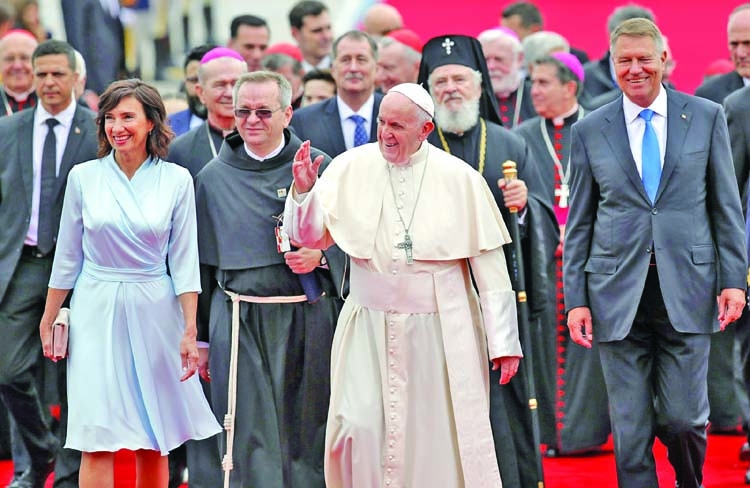Pope visits Romania 20 years after John Paul's historic trip

Pope Francis arrived in Romania on Friday for a three-day, cross-country pilgrimage that in many ways is completing the 1999 trip by St. John Paul II that marked the first-ever papal visit to a majority Orthodox country.
President Klaus Iohannis met Francis at the airport and the two huddled for a private meeting before Francis opened a series of meetings with Romania's political and religious leadership.Francis' visit comes on the heels of the European Parliament elections that hollowed out the political middle in the bloc, and Francis is expected to speak about issues confronting the continent during the trip.
Key moments are Francis' Mass for the largely Hungarian-speaking Roman Catholic faithful at the country's most famous Marian shrine, Sumuleu Ciuc, in eastern Transylvania. He will also beatify seven Greek-Catholic bishops who were martyred during communist rule, when Catholics were brutally persecuted. Francis will also meet with the patriarch of the Romanian Orthodox Church in the latest of his foreign trips to poor countries where Catholics are a minority.
In Romania, they are a divided minority between two Catholic rites, Roman Catholic and Greek-Catholic."I'm coming to you to walk together," Francis said in a videomessage released on the eve of his trip. The visit Friday includes a meeting with Prime Minister Prime Minister Viorica Dancila, whose Social Democratic Party, or PSD, was soundly defeated during the European Parliament elections.
While Francis' trip is pastoral, "I imagine that there might be speeches by the Holy Father on this European dimension," said Vatican spokesman Alessandro Gisotti. Later Friday, Francis and Patriarch Daniel, leader of the Romanian Orthodox Church, are to each recite the Our Father prayer in the Orthodox Cathedral, a towering new construction that was funded in part by a $200,000 donation by John Paul when he visited in 1999.
Gisotti stressed that while the two religious leaders would physically be praying in the same place, they would not pray together, an important distinction for many Orthodox. Ordinary faithful will be on hand, in sharp contrast to Francis' recent visit to Bulgaria, when he was allowed to pray in the Orthodox cathedral in Sofia, but alone.
John Paul's 1999 visit to Romania, just 10 years after the fall of the Berlin Wall, was the first by a pope to a majority Orthodox country since the Great Schism divided Christianity in 1054.It was marked by an extraordinary welcome for a Polish pope who helped bring down communism. During his Mass, shouts of "unity, unity" rose up from the crowd.
John Paul agreed to Orthodox demands that he visit only Bucharest and not Transylvania, where most of the country's Catholics live. In many ways then, Francis is fulfilling the itinerary John Paul would have completed.As then, the issue of confiscated property of the Catholic Church that was given to the Orthodox during communist rule remains a sore spot in relations. Gisotti said there were no plans for any public discussion of the dispute, but didn't rule out private talks.
"We live times of peace and understanding, but we wish these relations (between churches) to become better," said Francisc Dobos, spokesman for the Bucharest archbishopric. "We should not be afraid of one another, we should trust one another. This visit should make us become better Catholics and better Orthodox and in the end, better citizens."
